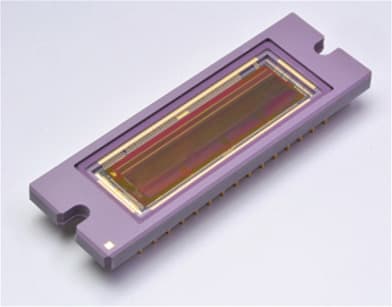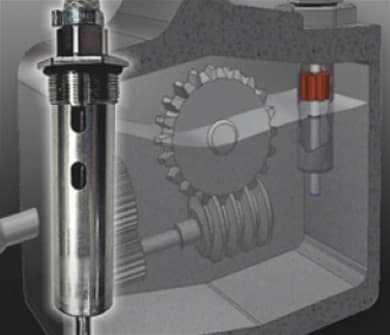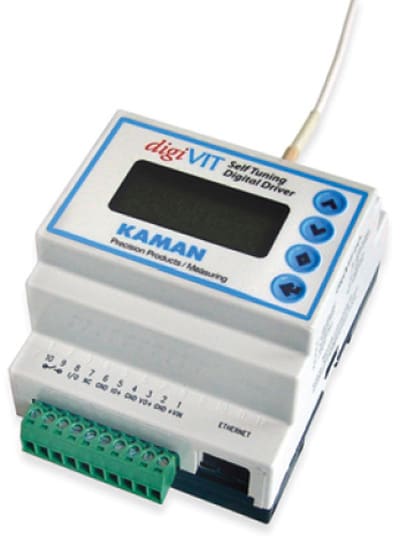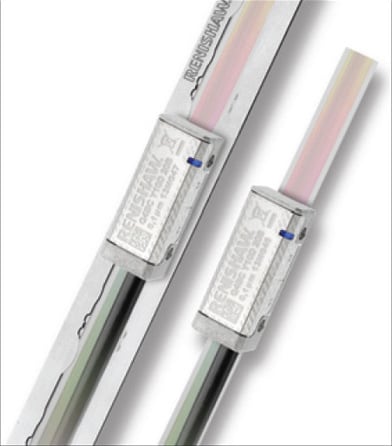CMOS Linear Image Sensor

The S13774 from Hamamatsu Corporation (Hamamatsu City, Japan; Bridgewater, NJ), is a CMOS linear image sensor developed for industrial cameras that require high-speed scanning. The column-parallel readout system, which has a readout amplifier and an A/D converter for each pixel, enables high-speed readout. For the A/D converter resolution, either 10-bit (high-speed mode: 100 klines/s max.) or 12-bit (low-speed mode: 25 klines/s max.) can be selected. Image data is output serially in 180 MHz LVDS format. Features include simultaneous integration of all 4096, 7×7 μm-sized pixels. There are built-in 10-bit/12-bit A/D converters, SPI communication function — and they operate from a -3.3 V power supply. Booth #: 1510
For Free Info Visit: Here
Reed Switch-Based Technology

Madison Company (Branford, CT) has developed an advancement in reed switch-based technology that provides ultra-high resolution, very tight tolerances, and consistent repeatable measurements in liquid level sensor applications. The sensors can be designed to withstand extreme shock or vibration as well as corrosive conditions and temperature variations.
Other options include temperature sensing, slosh shield for turbulence dampening, equipment performance compliance to specific standards, and a smaller than 1” diameter.
Typical applications include power generators, commercial compressors, power transmission equipment, chemical processing, and hydraulic systems. Booth #: 1609
For Free Info Visit: Here
Surface-Mount Silicon Avalanche Photodiodes (APDs)

The C30737MH Surface-Mount Silicon Avalanche Photodiodes (APDs) from Excelitas (Waltham, MA) are designed for high-volume, high-performance product designs that require maximal range at consumer price points. They have a small form factor package, and come in standard or customizable configurations. Responsivity is between 500 nm and 1000 nm, with fast rise times at all wavelengths and a cut-off frequency >1 GHz for some versions. They are available in two active area sizes: 230 μm and 500 μm, optimized for 800 nm or 900 nm light detection. Booth #: 1022
For Free Info Visit: Here
Eddy Current Sensor

The new digiVIT eddy current position/displacement/proximity sensor from Kaman Precision Products (Colorado Springs, CO) incorporates a self-tuning bridge. This eliminates the need to connect to a PC to download a configuration file when changing sensors or doing high level calibrations. At the beginning of any of the linearity calibration options, the digiVIT detects the sensor coil parameters with the target being used. The bridge that balances the circuit is then automatically tuned for optimum performance for that calibration range and target material. The digiVIT will perform with virtually any manufacturer’s inductive sensor. All functions can be accessed through four pushbuttons on the front panel. Booth #: 1217
For Free Info Visit: Here
NIR Spectral ID Sensor

ams AG (Premstaetten, Austria) has released the AS7265X 18-channel multispectral chipset, calibrated for the visible through near-infrared wavelengths. With a consumer-level price point, it is designed for emerging spectral sensing applications such as horticulture, fluid quality/spectral component analysis, and complex spectral identification, including anti-counterfeiting and authentication.
The chipset consists of 3 highly integrated 6-channel sensor devices, each 4.5 × 4.4 × 2.5mm, in land-grid array packages with integrated apertures. The master-slave-slave architecture appears as a single logical device, simplifying system integration. The 18 channels span wavelengths from 410 to 940nm with 20nm filter widths. They incorporate nano-optical interference filters deposited directly on the CMOS silicon die for precise and reproducible filter characteristics, and are stable over both time and temperature. In addition, they are much smaller than the typical component solutions needed for higher channel-count spectral analysis instruments. Calibrated at the factory, they deliver a normalized 35 counts/μW/cm2 across the entire sensed spectrum. Booth #: 232
For Free Info Visit: Here
Encoder Family for Linear Axes

Renishaw (Gloustershire, UK) has launched a new encoder family for linear axes that offers wide installation tolerances and axis speeds of up to 24 m/s. The QUANTiC™ encoder series produces a digital signal output directly from the readhead, thereby eliminating the requirement for additional external interfaces. The system uses a 40 μm-pitch scale, which translates to larger installation tolerances and higher operating speeds. The readheads incorporate Renishaw’s filtering optics that average the contributions from many scale periods and effectively filter out non-periodic features such as dirt. Signals are further enhanced by signal processing algorithms such as Auto Gain Control (AGC), Auto Offset Control (AOC), and Auto Balance Control (ABC). A third layer of signal filtering helps to eliminate non-harmonic signal frequencies that can occur due to contamination on the scale. These signal conditioning features combine to ensure low Sub-Divisional Error (SDE) and minimal signal variation over contamination. Booth #: 233
For Free Info Visit: Here
Precision Uni-/Bidirectional, Current-Sense Amplifiers

The MAX9918/MAX9919/MAX9920 from Maxim Integrated (San Jose, CA) are single-supply, high-accuracy current-sense amplifiers with a high input common-mode range that extends from -20V to +75V. They are well suited for current monitoring of inductive loads such as motors and solenoids, where common-mode voltages can become negative due to inductive kickback, reverse-battery conditions, or transient events.
The MAX9918/MAX9920 feature adjustable gain set by an external resistive-divider network. The MAX9919 features fixed gains of 45V/V (MAX9919F) and 90V/V (MAX9919N). The series operates as unidirectional amplifiers when VREFIN = GND and as bidirectional amplifiers when VREFIN = VCC/2. The MAX9920 attenuates the input signal by a factor of 4 at the input level-shifting stage allowing the device to sense voltages up to 200mV (unidirectional operation) or ±100mV (bidirectional operation). They all operate with a single 5V supply voltage and are specified over the -40°C to + 125°C automotive temperature range. Booth #: 1035
For Free Info Visit: Here

